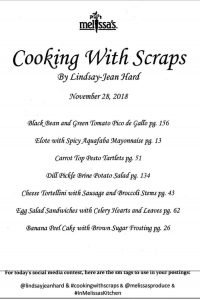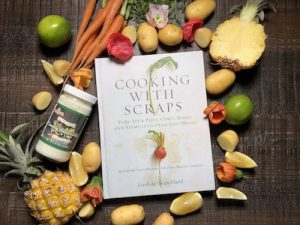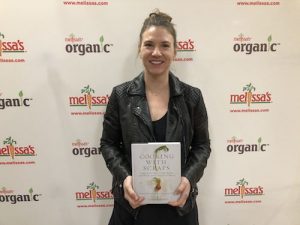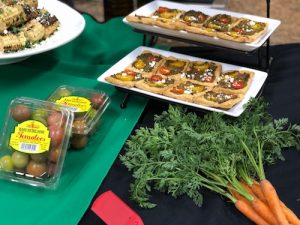How to Eat Mouth-watering Cake and Reduce Global Food Waste
(Gerry Furth-Sides, all photos courtesy of Melissa’s Produce) One of my more surprising recent passions, recycling and reducing food waste recently made the news. The others are the mission replace all foods with espresso (changed from ice cream until I was 18) and having a pet. I place this recycling intensity on the fact that it is logical, logical, logical! and that it is something every single human can do individually plus make an impact on the world without any sort of political thinking. Of course there is also the possibly my Austro-Hungarian practical ancestry had an impact on us from an early age. And yes. I am the “that one” going through the trash bins out front to put the recycled stuff where it belongs every week before trash pick-up. As I write this I am agonizing over what to do with chard stems, leftovers from baked chard leaves, in my fridge to avoid having them wind up in my compost bin.
So as a Valentine to the world, with the intention of getting people to waste less, here is one cookbook on what to do with foods you might throw away, and a fascinating research results on how purchasing food in bulk can lead to greater waste.
The statistics are grim: Americans currently produce 133 pounds of food waste every year, and 40 percent of food in this country goes uneaten. For the first time ever, the USDA has set a nationwide goal to reduce food waste by 50 percent by the year 2030. A recent Melissa’s Produce guest, Lindsay-Jean Hard explained her new book COOKING WITH SCRAPS (Workman Publishing) which provides 80 creative, delicious, and inspired recipes to help home cooks meet this important goal. 
 She shared her basics behind transforming food waste into treasure, so readers can take advantage of ingredients such as outdated produce, cheese rinds, stale bread, and other oft-discarded foods to create budget-conscious, sustainable, and highly satisfying meals. Lindsay-Jean explains, “What lies unused in one’s fridge or pantry is not a purposeless object destined for the waste bin! For the most part, you’ll find recipes for the often unused parts.”
She shared her basics behind transforming food waste into treasure, so readers can take advantage of ingredients such as outdated produce, cheese rinds, stale bread, and other oft-discarded foods to create budget-conscious, sustainable, and highly satisfying meals. Lindsay-Jean explains, “What lies unused in one’s fridge or pantry is not a purposeless object destined for the waste bin! For the most part, you’ll find recipes for the often unused parts.”
Organized by ingredient, from apples to zucchini, Lindsay-Jean’s recipes include repurposing unused parts of produce and pantry item from bones and brine to pits and peels. Samples:
- Asparagus: Charred Asparagus End Pesto
- Bananas: Banana Peel Cake with Brown Sugar Frosting
- (Stale) Bread: Crispy Breadcrumb Fried Eggs
- Carrots: Carrot Top Pesto Tartlets
- Cheese: Brothy Beans with Roasted Garlic and Parmesan Rind
- Pineapple: Pineapple Peel and Core Lemonade with Mint
Lindsay-Jean Hard earned her Master’s in Urban Planning from the University of Michigan. Her education and passion for sustainability went on to inform and inspire her work in the garden, home, and community. Linday-Jean lives in Ann Arbor, Michigan – a city that I revere, not only because her employer, Zingerman’s, is one of my favorite delis in the world or because I went to U of M there, but because Ann Arbor boasts one of the best recycling programs in the world.
New article Nearly one-third of all food within a household is wasted. Yet, despite ambitious programs in the US, EU and UN to reduce food waste by half by 2030, public efforts to reduce food waste with consumer-facing campaigns have met with limited success. After initial success in the United Kingdom’s initiative to reduce household food waste, it began rising again in 2012. And similarly, a Netherlands public program initiated in 2009 to household food waste met with no success.
Stephen F. Hamilton from Cal Poly San Luis Obispo and Timothy James Richards from Arizona State University, co-authored a new article in AJAE, “Food Policy and Household Food Waste.”
Hamilton says, “one reason that consumer-facing programs have had limited success in reducing food waste is that food waste depends both on food purchases and food utilization, and reducing household food utilization costs can cause households to buy more food. Much like having a bigger refrigerator makes utilizing food less costly but can lead to larger purchases of food,” this pretty much boils down to purchasing larger quantities of food because of cheaper pricing, a la COSTCO and not using it.
The article results also inform on how social policies such as food support programs can impact food waste, and clarify the need for future research to understand whether households targeted by food policies have elastic food demand.”
The article is now available online for a limited time. Information on AAEA and their publications can be found at: Agricultural & Applied Economics Association (AAEA) is the leading professional association for agricultural and applied economists, with 2,500 members in more than 60 countries, and was founded in 1910.





 Gerry Furth-Sides
Gerry Furth-Sides  Barbara Hansen
Barbara Hansen  Chef-owner Alain Cohen
Chef-owner Alain Cohen  Roberta Deen
Roberta Deen  Jose Martinez
Jose Martinez  Nivedita Basu
Nivedita Basu